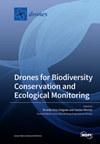Wind Tunnel Balance Measurements of Bioinspired Tails for a Fixed Wing MAV
IF 4.4
2区 地球科学
Q1 REMOTE SENSING
引用次数: 0
Abstract
Bird tails play a significant role in aerodynamics and stability during flight. This paper investigates the use of bioinspired horizontal stabilizers for Micro Air Vehicles (MAVs) with Zimmerman wing-body geometry. Five configurations of bioinspired horizontal stabilizers are presented. Then, 3-component external balance force measurements of each horizontal stabilizer are performed in the wind tunnel. The Squared-Fan-Shaped Horizontal Stabilizer (HSF-tail) is selected as the optimal horizontal stabilizer that provides the highest aerodynamic efficiency during cruise flight while maintaining high longitudinal stability on the vehicle. The integration of the HSF-tail increases the aerodynamic efficiency by more than 6% up to a maximum of 17% compared to the other alternatives while maintaining the lowest aerodynamic drag value during the cruise phase. Furthermore, balance measurements to analyze the influence of the HSF-tail deflection on the aerodynamic coefficients are conducted, resulting in increased lift force and reduced aerodynamic drag with negative tail deflections. Lastly, the experimental data is validated with CFD-RANS steady simulations for low angles of attack, obtaining a relative difference on the measurement around 5% for the aerodynamic drag coefficient and around 10% for the lift coefficient during the cruise flight that demonstrates a high degree of accuracy in the aerodynamic coefficients obtained by external balance in the wind tunnel. This work represents a novel approach through the implementation of a horizontal stabilizer inspired by the structure of the tails of birds that is expected to yield significant advancements in both stability and aerodynamic efficiency, with the potential to revolutionize MAV technology.固定翼无人飞行器生物启发尾翼的风洞平衡测量
鸟类的尾巴在飞行过程中对空气动力学和稳定性起着重要作用。本文研究了生物启发水平稳定器在具有齐默尔曼翼身几何形状的微型飞行器(MAV)中的应用。本文介绍了生物启发水平稳定器的五种配置。然后,在风洞中对每个水平稳定器进行了 3 分量外部平衡力测量。方形扇形水平稳定器(HSF-tail)被选为最佳水平稳定器,可在巡航飞行中提供最高的气动效率,同时保持飞行器的高纵向稳定性。与其他替代方案相比,HSF-尾翼的集成将气动效率提高了 6%以上,最高可达 17%,同时在巡航阶段保持最低的气动阻力值。此外,还进行了平衡测量,以分析 HSF 尾翼偏转对气动系数的影响,结果是负尾翼偏转时升力增加,气动阻力减少。最后,实验数据与低攻角的 CFD-RANS 稳定模拟进行了验证,在巡航飞行中获得的气动阻力系数与测量值的相对差异约为 5%,升力系数约为 10%,这表明在风洞中通过外部平衡获得的气动系数具有很高的准确性。这项工作代表了一种新方法,即从鸟类尾部结构中汲取灵感,实施水平稳定器,有望在稳定性和气动效率方面取得显著进步,并有可能彻底改变无人飞行器技术。
本文章由计算机程序翻译,如有差异,请以英文原文为准。
求助全文
约1分钟内获得全文
求助全文

 求助内容:
求助内容: 应助结果提醒方式:
应助结果提醒方式:


